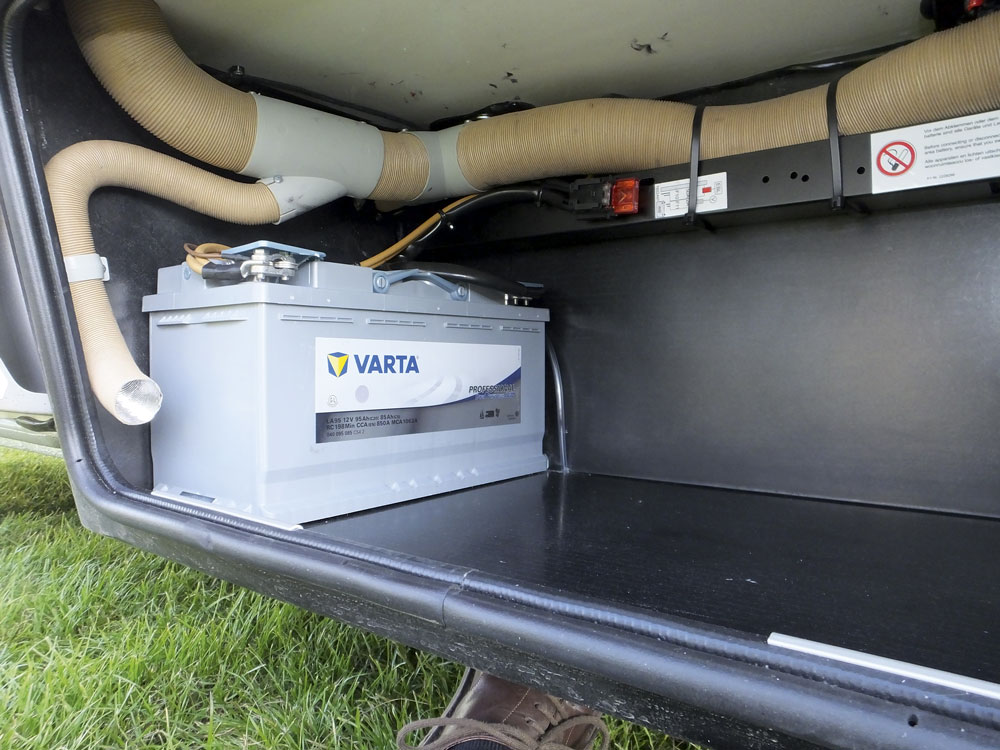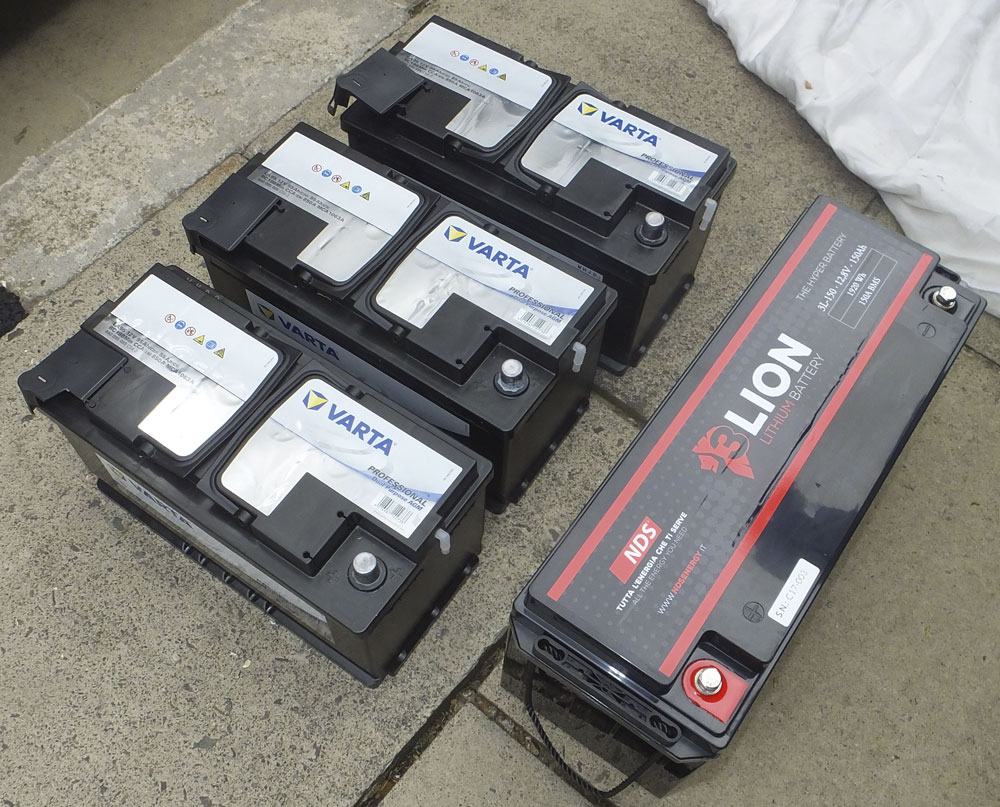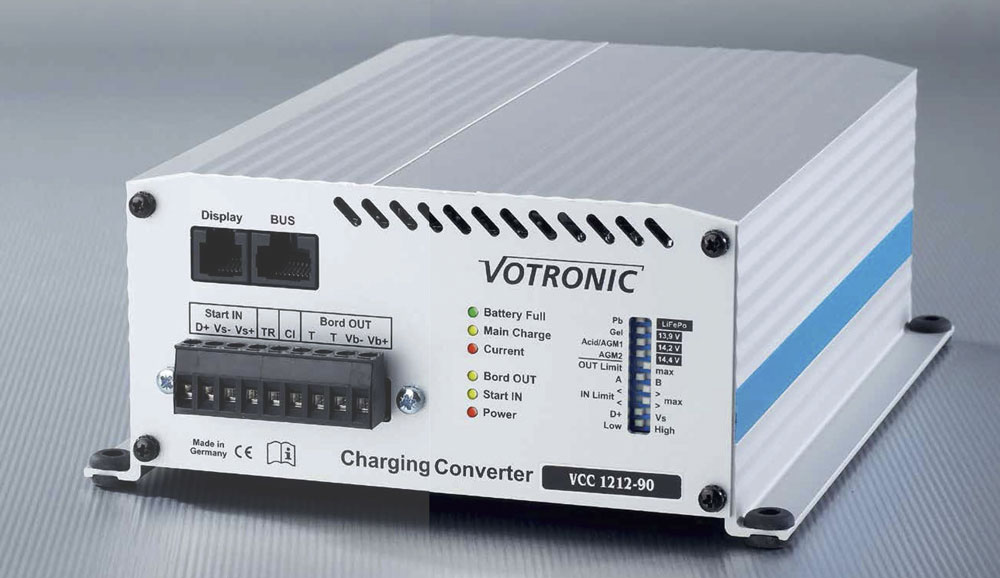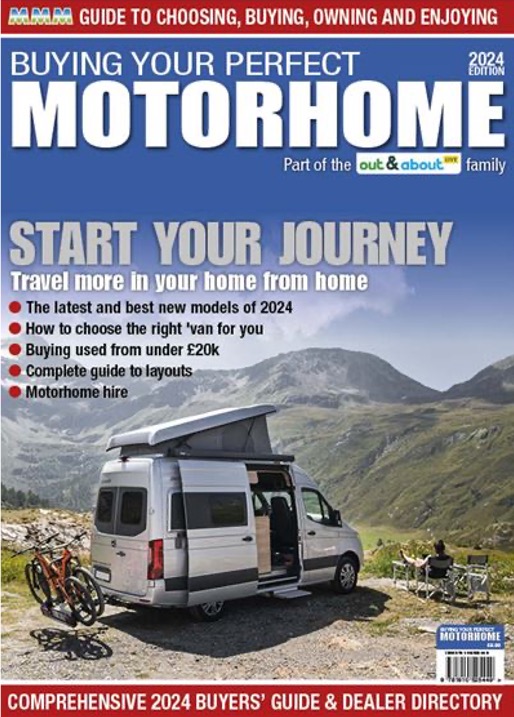The lowdown on leisure batteries - is lithium right for your motorhome?
A leisure battery keeps all modern motorhome systems running. Even if you have a gas fridge, its electronics run from the leisure battery. So do the heating, cooking and hot water systems. Even flushing the loo requires volts!
Page contents
- Introduction
- Power-hungry items
- The lowdown on lithium batteries
- Charging leisure batteries
- Lithium ferrous cost
- Warranty for lithium ferrous batteries
- Our magazines
Words by Clive Mott
Introduction
The National Caravan Council (NCC) has a scheme that has looked at verifiable test data for a range of batteries. Class A batteries have the most capacity and largest life cycle figures. Look for the NCC Class A label on the battery.
The type of battery you need depends on your camping lifestyle.
If you only stay at campsites with hook-up then most standard leisure batteries will satisfy your needs, as they only need to power your systems when you stop for a cuppa en route. Some CLs and temporary sites have low-power hook-ups, typically 6A, so don’t try and run the electric kettle and toaster at the same time. However, most campsites in the UK offer a 16A hook-up.
Then you have those motorhomers who regularly stop for a night en route to their chosen campsite, yet still want all the home comforts, including such things as a microwave powered by an inverter. These inverters generate a ‘mains’ AC voltage and the more-expensive pure sine wave variants also match the shape of the mains voltage. The cheaper quasi-sine wave units may work with all equipment, so check before buying.
Typically inverters are used for powering phone and laptop chargers, where a 150W unit should be sufficient. If you’re charging electric bikes then look at a 600W inverter. If you want a microwave, you will need to use an inverter of around 1,500W to power it, which will use 125A so you’ll need beefy cabling to handle this. Even a 600W (output) microwave will still take nearly 90A from a leisure battery via the inverter. If this is your lifestyle then probably two 100Ah batteries will be required to support such an inverter and microwave combination, even if you’re only using it to warm pasties!
Moving up from this scenario are those motorhomers who wild camp a little more often. They need to consider how much battery energy they require and how much they can carry. To quantify how much energy, or how many amps, is needed, one first needs to convert all the outputs into amps, as we quantify batteries in ampere hours (Ah). To do this, you must divide the wattage figure by the voltage (12V in this case). Once you have this figure you can start to consider batteries.
Quality deep-cycle batteries would be best. Lead acid batteries have a finite cycle life and these are best protected by not draining them down to more than half of their total stored ampere hours. Life cycle figures are given for this 50% depth of discharge figure (DOD). So, in reality, a 100Ah battery should be considered to be only a 50Ah battery. Lead acid batteries are made to a price and the cheaper batteries will have a shorter service life and less life cycles.
The final scenario is the frequent wild camper. To keep going in this scenario you need a reliable source of power, of which solar panels are ideal.
Solar panels are silent in operation, so fit the biggest you can. Make sure you have the appropriate MPPT (maximum power point tracking) solar regulator to maximise the panel’s output and match the battery technology and, if required, a regulator that can charge both leisure and starter batteries.
It’s also worth considering a battery-to-battery (B2B) charger, which takes power from the starter battery when the engine is running to charge the leisure battery faster than a conventional split charge relay.
If your motorhome has an ‘intelligent alternator’ that converts braking energy into electrical energy to fast charge the starter battery then your motorhome may have a B2B unit already installed.
These are tailored to suit different types of battery, so choose wisely if you see one of these as a method of quickly recharging your leisure battery during 60 minutes of engine running.
Power-hungry items

(Photo courtesy of Clive Mott)
When considering batteries, be aware of devices that take lots of amps:
Diesel heaters – Any diesel heating system, water or space, has a pump to squirt diesel through a small jet to make a mist and a glow plug to light this mist. Glow plugs can take 20A for several seconds each time the heater is started and this happens frequently because of the thermostat. The diesel pump and a fan are also running all the time the heater is burning and consuming from 1A to 3A.
Compressor fridges – These are more efficient than a three-way gas fridge but take a lot of power from your leisure battery, typically 5A when running under thermostatic control. So they work out at around an average of 2A if you don’t want too much cold beer. If you simply multiply the amps taken by the hours running you have the ampere hours consumed. This is 24 (hours) x 2 (A) = 48Ah a day. Top-loading compressor fridges are the best of this bunch.
Lighting is no longer power-hungry and LED lighting is by far the most economical. A 2W LED lamp (taking only 0.17A) will provide similar illumination to a 20W quartz halogen bulb. By comparison that 20W halogen bulb would take 1.7A – 10 times as much current.
For heating systems, you need to be looking at gas-powered units. Remember, a 6kg gas bottle contains as much energy as over 60 fully charged 100Ah batteries, so it can be better to use gas for anything that requires heat.
A Whale heating system takes about 1.7A when running and 0.01A on standby. The Truma Combi has similar electrical requirements when used for space heating. Both have a gas solenoid to energise them and a fan to blow the air.
The Alde wet system is more economical, requiring 0.4A for water heating only and 0.6A for hot water and space heating.
If your camping lifestyle cannot quite be supported by one leisure battery, then adding another matching battery is the best way to double your independence. Make sure that each leisure battery has its own in-line fuse for safety.
Not all motorhomes require the same type of battery. Motorhomes from Swift and Auto-Trail have a Sargent electrical system and these are best served with a wet lead acid battery, which is suitable for the vehicle charging regime.
Modern Hymer motorhomes are different, with Schaudt electrics with a different charging regime, and come from the factory fitted with AGM batteries. If you want to change the battery type, then check the manual.
Other charging systems include wind generators and fuel cell systems, such as the Efoy range that run from methanol and trickle charge batteries. Fuel cells make no more noise than a laptop computer.
The lowdown on lithium batteries

(Photo courtesy of Clive Mott)
Over the past few years a new breed of batteries has arrived that is driving electric cars and is now filtering into the leisure vehicle battery market. These offer more capacity, less weight and a longer life.
Motorhomers will come across two types of lithium battery, both have a much better life expectancy compared to traditional lead-based batteries in the order of 10 times.
One type is lithium ion, which is used in devices such as phones and tablets, as well as electric bikes as it offers high amounts of energy storage for minimal weight. Like all batteries, each is a collection of serially connected cells so that the output is the addition of each cell voltage.
Most phones or tablets use one lithium ion cell and this voltage will typically be between 3.6V and 4.2V when fully charged.
Many ebikes have 10 cells serially connected and operate between 36V and 42V. Frequently these use several sets of 10 cells connected in parallel to increase capacity.
A problem comes with this cell type when one wants to replace a nominally 12V lead acid battery with lithium; the operating voltage of the cells spanning 14.4V to 16.8V is too high if you use four cells, or too low if you use three cells (giving a voltage of 10.8V to 12.6V).
The other type of lithium cell construction uses the metal iron in its chemistry, lithium iron ferro phosphate being the name and LiFePO4 the shortened version. So we have lithium ion and now also lithium iron! To minimise confusion, let’s call these iron variants lithium ferrous.
Four lithium ferrous cells have a typical end of charge voltage of 14.6V, give or take a small tolerance (0.1V or 0.2V). This is very close to the voltage required for lead acid batteries.
Several sources suggest the use of dedicated lithium charging systems that simply switch off at 14.6V and on again at a much lower voltage, while many say that the LiFePO4 battery can be used as a direct replacement for a lead acid battery.
Other advantages provided by lithium ferrous batteries are intrinsic safety (compared to lithium ion which have been known to catch fire), the ability to discharge regularly to 90% without seriously compromising the battery life and lower weight.
If you factor in the general advice not to discharge a lead acid battery below 50%, then a 50Ah lithium ferrous battery can provide the same amount of useable energy as a nominal 100Ah lead acid battery.
I have replaced three 95Ah AGM lead acid batteries with one early-generation 150Ah lithium ferrous battery, which has saved us 61kg. This weight saving was the fundamental reason for changing.
All lithium ferrous batteries consist of many cells connected in both series and parallel. Several cells are connected in parallel to provide the required ampere-hours, and four sets of parallel-connected cells are then connected in series to provide the required output voltage.
Individual cell construction is either cylindrical or prismatic. Prismatic cells nest together better as the shapes fit together, cylindrical cells laying alongside each other waste more space but are said to have a better cycle life.
Charging lithium batteries

(Photo courtesy of Clive Mott)
Lithium ion and lithium ferrous batteries can accept large amounts of charge current and provide large discharge currents; however, this technology is fragile in that it can be damaged by gross overcharge or gross overdischarge. To protect against this, inside each battery there is a battery management system (BMS) that monitors the voltage of every cell and will switch off the battery if the set voltage limits are reached for any cell.
If you run a hair dryer or even a microwave via an inverter then you need a battery with a BMS of around 150A. A 50A BMS will be insufficient.
A lead acid battery does not have a BMS. Another difference is the working temperature range for lithium ferrous batteries. The range for discharge is typically -10˚C up to 60˚C. The range for charging is more limiting, being typically between 0˚C up to 40˚C.
Don’t try to charge a lithium ferrous battery if it has been left in a sub-zero environment for a while as you can do permanent damage if the BMS does not provide temperature protection.
The advice is to mount lithium ferrous batteries inside the living area of a motorhome to keep them safe.
Starting up a motorhome with a fast B2B leisure battery charging system that has been stood empty overnight in sub-zero temperatures can lead to rapid damage if protection is not built in.
Not all BMS systems are the same. Some provide cold protection, while others do not.
Lithium ferrous cost
Currently, prices are about £10 per ampere hour for most, but competition and increasing popularity means that prices are coming down.
Many lithium ferrous batteries are supplied with an external display panel where their operation can be monitored, including percentage of capacity remaining, charge current and voltage. Some batteries include bluetooth and are supported by a phone or tablet app.
Lavi offers a premium package including a built-in B2B fast charger and solar regulator all in one box. A few have grasped the nettle regarding sub-zero charging and have heaters inside the battery that use the charging energy to power the heaters initially until the battery has got up to working temperature.
Hymer has partnered with Bos to create a Lego-type battery arrangement. The Hymer 135Ah lithium ferrous battery is a sandwich of six Bos LE300 12V units put together as one block. Hymer has downrated the 153Ah battery to 135Ah to prolong cycle life and offers three variants using lithium ferrous and lead batteries alongside each other so that the high currents come from the lead-based batteries, which also accept a charge in sub-zero temperatures. The lithium batteries also include heaters.
Warranty for lithium ferrous batteries
Even if fully charged and discharged every day, the warranty in most cases would expire well before a typical user had reached the published cycle life of a lithium ferrous battery.
Transporter Energy offers the best warranty of 10 years with its 100Ah battery and the internal BMS protects the battery should the temperature become excessively high or low, stopping charging at -4˚C.
If your priority is maximum capacity, fast charging and discharging and minimum weight and space then you need to look seriously at lithium ferrous batteries.
Get MMM for just £29.99 a year!

MMM is Britain’s best-selling motorhome magazine and it has been for over 55 years. Each four-weekly issue is packed with the best motorhome travel features, genuine reader reviews of campsites, in-depth motorhome reviews, plus the latest technical advice, buying tips and much more.
MMM’s fully searchable digital library gives you access to the latest issues, plus every edition of MMM since January 2012.
Buying Your Perfect Motorhome, the 2024 edition is available now, including everything you need to know about your first motorhome, with essential guides, top tips and buying advice available to buy here
Buying Your Perfect Motorhome 2024

Looking for more great motorhome and campervan buying information? You need the brand-new guide to Buying Your Perfect Motorhome, it’s packed with everything you need to help you with choosing, buying, owning and enjoying your very first motorhome or campervan.
Learn more about it here.
Digital Download it now from Pocketmags for just £9.99.
Printed Or order a printed edition for just £9.99.
Expert motorhome advice to your door!
Why not subscribe to one of our fabulous magazines and get expert advice, travel ideas, technical help and all the latest news for your motorhome and your motorhome adventures!

Want to know more about MMM magazine?
Every month MMM has articles written by motorhomers who have been there and done it, from great UK and European (and further afield) tours, campsite reviews, owners' reports and DIY projects among other things.
MMM's tests, reviews and expert buying guides are not to be missed. MMM's technical advice is a must and includes everything from weekend jobs to longer-term DIY projects. And much more!
About MMM magazine
Want to know more about What Motorhome magazine?
Every issue of What Motorhome magazine provides essential buying advice for anyone looking to buy a new motorhome or campervan or upgrade their existing model. With a pedigree of over 30 years of offering the best motorhome and campervan buying advice, every issue of What Motorhome includes more new motorhome and campervan reviews than you will find in any other magazine.
About What Motorhome
Want to know more about Campervan magazine?
Campervan is the exciting monthly magazine that will give you all the inspiration you need to explore the world in your campervan. Every issue is packed with real-life campervanning experiences, inspiring travel ideas in the UK and further afield, the best campsites to stay on, campervan road tests and reviews of the latest models, and much more!
About Campervan magazine







Recent Updates
Engine management lights: all you need to know
What is the engine management light? What does it mean, and what do I have to do? ...
Motorhome air suspension: all you need to know
Motorhomes are heavy and the additional weight of equipment and height of the bodywork can increase the loads ...
Motorhome WiFi: how to get better motorhome internet
Staying connected on the move is more and more essential, so relying on campsite WiFi isn't an option – here ...
A class of their own - our guide to A-class motorhomes
Thinking of trading up to an A-class, or even going straight to the top of the motorhome tree? We guide you ...
Explore overseas on a motorhome dream tour
Enjoy exotic travel in a campervan or motorhome by hiring, swapping with someone else or exporting your ...
Motorhome water systems: everything you need to know
On-board water is an important part of every motorhome – here’s everything you need to know ...
Campervanning in Europe: what you need to know
Whether you're planning a leisurely drive through the French countryside, navigating bustling city streets in ...
Campervan security: all you need to know
With thefts on the increase, it’s important to know how to keep your campervan secure and prevent campervan ...
Campervan furniture: everything you need to know
Our campervan experts guide you through all the essentials for your campervan, including tables, chairs, ...
Campervan finance: how to fund your purchase
Here we look at the different types of campervan finance available, to help you decide what’s the best option ...
Other Articles
Britain’s best used motorhomes
Want a great motorhome without paying the premium for a new one? Here's a guide to the best you can get in the pre-owned market for each layout, ...
Which motorhome? Choosing the perfect motorhome for you
Choosing a motorhome or campervan is one of the biggest buying decisions you’ll ever make, so it's important ...
Campervan washroom essentials: stay fresh on the road
Our guide will take you through the campervan washroom essentials you'll need so you're well-prepared for ...
Dogs in campervans: all you need to know
Follow our advice and your dog will enjoy campervanning as much as you do ...
Electric campervans: all you need to know
Our guide will take you through everything you need to know about electric campervans and what the future ...
Motorhome electrics: a complete guide to your motorhome electrical set-up
Motorhome electrics can dramatically enhance the convenience and comfort of your vehicle – but they can be ...
Lighting for campervans: all you need to know
We guide you through all the lighting options available for you and your campervan, including interior ...
Electric bikes for motorhomes: our ultimate guide
Read our comprehensive guide to electric bikes for motorhome owners, helping you add electric power to your ...
Our guide to 'cheap' motorhomes in 2024
If you're on the hunt for an affordable new motorhome, this is the best place to start – we've rounded up a ...
Campervans in winter: all you need to know
Here's your guide to preparing your campervan for the colder months, whether you will be using it or putting ...